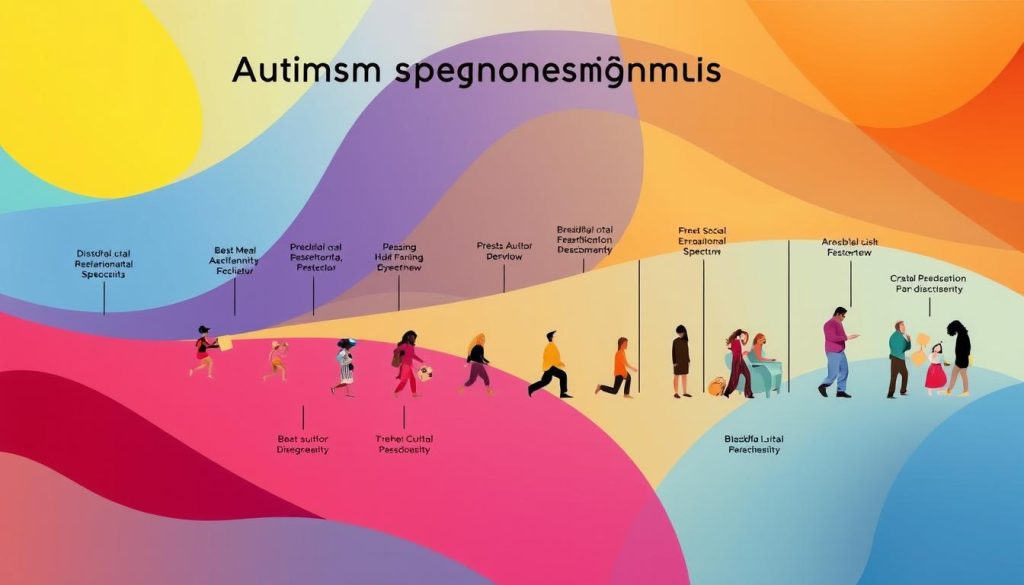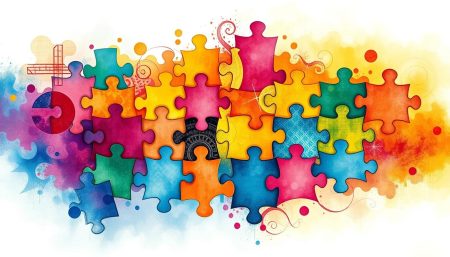Understanding autism spectrum disorder levels is key to better support. This guide helps you grasp ASD severity levels better. It’s for those who want to understand understanding ASD and its effects.
The autism spectrum covers a wide range of challenges. These can affect how people interact, communicate, and behave. Our guide aims to show the different experiences of those on the autism spectrum. This helps us offer better support and help.
Let’s explore a detailed look at whether autism is a mental health condition. Check out this in-depth overview.
Understanding Autism Spectrum Disorder
Autism Spectrum Disorder (ASD) is a group of conditions that affect how people think, feel, and interact. Each person with ASD is different, showing varying levels of severity. This means we need to understand and support each person in their own way.
ASD can impact how well someone thinks, feels, and interacts with others. It can be mild or severe. Getting a diagnosis early is important for better management and outcomes. But, finding the right diagnosis can be hard because of the wide range of symptoms.
- Early signs often include delayed speech development, difficulties in social interactions, and repetitive behaviors.
- Diagnosis involves a combination of behavioral assessments and developmental monitoring, tailored to capture the broad spectrum of ASD manifestations.
- Understanding and recognizing the breadth of ASD diagnosis types enhances the accuracy of assessments, ensuring that each individual receives the most appropriate support and resources.
Every case of ASD is unique, leading to many misconceptions. It’s important to clear up these myths. Not everyone with ASD shows obvious signs, and the severity can vary a lot. This often leads to underdiagnosis or misdiagnosis.
The term ‘spectrum’ in ASD shows how different each person’s needs and abilities are. In conclusion, learning about the different levels of autism spectrum disorder severity and how to handle ASD diagnosis types is essential. It helps us better understand and support those with ASD.
Autism Spectrum Disorder Levels Explained
To understand autism spectrum disorder, we must see its complexity. The classification of autism spectrum disorder helps doctors tailor care for each person. This makes sure everyone gets the right help.
Defining the Spectrum: Variability in ASD
The autism spectrum shows a wide range of symptoms and abilities. This means each person on the spectrum faces different challenges and strengths. Accurate identification of levels of autism severity is key.
Level 1: ‘Requiring Support’
People at Level 1 have minor social communication issues. They can handle most daily tasks but need help with organization and planning.
Level 2: ‘Requiring Substantial Support’
At Level 2, more support is needed. Verbal and non-verbal communication challenges are more obvious. Social impairments are clear, even with support, requiring more intense help.
Level 3: ‘Requiring Very Substantial Support’
Level 3 faces severe communication challenges and everyday life difficulties. They need constant, intensive support to manage their symptoms.
| Level of Support | Communication Challenges | Social Skills | Required Interventions |
|---|---|---|---|
| Level 1 | Mild | Struggles with organizational skills | Support with planning and social interactions |
| Level 2 | Moderate to severe | Obvious issues even with support | Substantial support in both school and social settings |
| Level 3 | Severe | Very limited social skills | Very substantial, continuous support |
Understanding the different levels of autism spectrum disorder is key to effective treatments. This approach ensures each person gets the right support to thrive.
Evaluating ASD Severity Levels
It’s key to check ASD severity levels to help those with autism spectrum disorder (ASD). Experts use many tools and criteria to find out what each person needs. This helps make treatments that really meet their unique challenges.
Assessments are done to sort out how severe ASD is. It’s divided into three main levels. Each level shows how much support someone needs, guiding how to help them in school and daily life. Knowing this is important for doctors, teachers, and families.
| Level | Description | Typical Support Needed |
|---|---|---|
| 1 | Requiring Support | Minimal; occasional support mainly in social and communication skills. |
| 2 | Requiring Substantial Support | Moderate; frequent support in communication and repetitive behaviors. |
| 3 | Requiring Very Substantial Support | Constant, intensive support in all areas of daily and social functioning. |
To figure out ASD severity levels, experts watch behavior, talk to caregivers, and use special tests. Getting the right autism spectrum disorder grade helps doctors understand what someone can do and what they struggle with. This is a big part of managing and caring for ASD.
The Diagnosis of Autism Spectrum Disorder
Diagnosing Autism Spectrum Disorder (ASD) is a detailed process. It involves clinical assessments, standardized tests, and analyzing results to understand the individual’s condition. This section explores these important steps.
Clinical Assessment and Observation
Diagnosing ASD begins with clinical assessments. These include looking at developmental history and observing behavior. Healthcare professionals do these evaluations to spot early signs of ASD.
Role of Standardized Tests in ASD Diagnosis
Standardized tests are key in diagnosing autism. They measure social interaction, communication, and behavior patterns. These tests give clear data, helping to understand the severity of autism.
Interpreting Results and Severity Grading
After analyzing clinical observations and test results, the severity of the disorder is graded. This grading is based on the autism severity scale. It helps create personalized intervention plans, ensuring each person gets the right support.
Criteria for ASD Diagnosis Types
Diagnosing autism spectrum disorder (ASD) needs a detailed framework. This ensures accurate and consistent diagnoses. We’ll look at the criteria for different ASD diagnosis types and how they fit into the autism spectrum disorder classification system.

Identifying different ASD types requires observing behavior and developmental history. The criteria aim to capture the unique aspects of ASD across the spectrum.
- Consistent deficits in social communication across multiple contexts.
- Restricted, repetitive patterns of behavior, interests, or activities.
- Symptoms must be present in the early developmental period (typically recognized in the first two years of life).
- Symptoms cause clinically significant impairment in social, occupational, or other important areas of current functioning.
- These disturbances are not better explained by intellectual disability or global developmental delay.
Autism spectrum disorder classification is key for creating personalized interventions. Experts use clinical assessments and standardized tests to create a diagnosis that matches the individual’s needs and challenges.
Impact of Autism Severity Levels on Daily Life
Looking into the different levels of autism spectrum disorder shows a wide range of challenges. These challenges affect daily life in many ways. The autism severity scale shows how much support and help each person needs.
Challenges in Communication and Social Interaction
For those on the autism spectrum, talking and socializing can be tough. This gets harder as the autism gets more severe. Some might struggle to understand social hints, while others might barely speak at all.
Because of this, it’s important to find ways to help them communicate better. This can make it easier for them to connect with others.
Behavioral Patterns and Routines
People with autism may rely a lot on routines and certain ways of doing things. For those with more severe autism, changes in routine can be very upsetting. This shows why having a regular schedule and a structured environment is so important.
Adaptive Skills and Independence
Adaptive skills, like getting dressed or eating, are affected by how severe the autism is. People with milder autism might be very independent. But those with more severe autism might need help their whole lives.
Strategies for Managing Different Levels of Autism Spectrum Disorder
Managing autism spectrum disorder (ASD) needs tailored approaches for each level. It’s important to use strategies that fit each person’s needs. This helps support those with autism in meaningful ways.
Personalization of intervention plans is key. The right strategies depend on the severity and individual needs. Teams of professionals work together to create plans that meet each person’s unique needs.
- For Level 1 – ‘Requiring Support’: Focus on social skills and adaptive behaviors with minimal support.
- For Level 2 – ‘Requiring Substantial Support’: Intensive behavioral interventions and structured teaching are needed.
- For Level 3 – ‘Requiring Very Substantial Support’: Use of pharmacological treatment, intense therapy, and round-the-clock care is common.
Engagement and communication tailored to each person’s needs are essential. Therapies like Applied Behavior Analysis (ABA), Occupational Therapy, and Speech Therapy are adapted for each level. The choice of therapy depends on the individual’s challenges and strengths, aiming for a better quality of life and independence.
Caregiver and family education is also vital. Teaching families about autism strategies empowers them. It ensures consistent management strategies in all settings, like home, school, or community.
In summary, managing ASD levels effectively requires a holistic approach. This includes personalized interventions, family involvement, and professional support. Such efforts help individuals with ASD reach their full developmental and life potentials.
Autism Spectrum Disorder Classification System
The way we classify autism has changed a lot with the DSM-5. This change shows we now understand autism better. It also helps make sure doctors everywhere use the same rules to diagnose it.
The Role of the DSM-5
The DSM-5 changed how we look at autism. The American Psychiatric Association made these changes. They combined different autism diagnoses into one, making it easier to treat everyone the same.
Transitioning from DSM-IV to DSM-5
Going from the DSM-IV to the DSM-5 was a big deal. Before, doctors had different names for autism-like conditions. The DSM-5 brought them all together under one name. This makes it easier to help people with autism.
Controversies and Acceptance in the Medical Community
Even though the DSM-5 is widely used, some doctors disagree. They worry it might lead to too many false diagnoses. But many doctors think it’s better because it recognizes more types of autism.
Family Perspectives on Autism Spectrum Disorder Levels
The family impact of ASD can be very different, showing the complex challenges and experiences at each autism level. It’s important to see how families adapt and stay connected through these challenges. This helps us understand autism from a family point of view.
Families with autism go through big changes as they deal with diagnosis and learning to adapt. These stories show the strength and flexibility needed to live with ASD. Here are some accounts of how ASD affects family life.
- Initial Diagnosis: The mix of emotions and choices after a child’s diagnosis.
- Daily Life Adaptations: Changes in routines and places to meet a child’s needs.
- Educational Choices: Decisions on schools and special education plans.
- Social Dynamics: How family and social interactions change.
Looking at data also helps us see the wide family impact of ASD. The table below shows common challenges and how families cope at different ASD levels.
| ASD Level | Common Challenges | Adopted Strategies |
|---|---|---|
| Level 1 | Minor social and communication hurdles | Social skills training, structured routines |
| Level 2 | Moderate difficulties in verbal and nonverbal communication | Enhanced communication devices, behavioral interventions |
| Level 3 | Severe challenges in social situations and repetitive behaviors | Comprehensive daily assistance, specialized therapeutic programs |
In conclusion, looking at autism from a family’s point of view shows both personal struggles and collective strength. Every family’s journey is unique, but they all aim for balance and happiness despite ASD’s challenges.
Education and Autism Spectrum Disorder Severity
The challenges and needs in autism spectrum disorder education grow as we learn more. It’s important to understand how special educational plans and settings help these students learn.
Individualized Education Plans (IEPs)
Individualized education plans are key in autism spectrum disorder education. They are made to fit each student’s unique needs. Teachers, therapists, and families work together to create a supportive learning environment.
Inclusion vs. Specialized Education Settings
The debate on whether students with ASD should be in regular classrooms or special settings is important. Inclusive classrooms aim to integrate students with ASD into general education. On the other hand, special settings offer customized curricula and extra support.
Transitioning to Adulthood and Lifelong Learning
As students with ASD grow older, education focuses on preparing them for adulthood. This is vital for developing life skills and ensuring they can live independently.

| Education Setting | Pros | Cons |
|---|---|---|
| Inclusive Classroom | Promotes social integration Fosters a sense of belonging | Potentially overwhelming May lack individualized attention |
| Specialized Setting | Customized support Targeted teaching methods | Limited social interaction Can be isolating |
Autism Spectrum Disorder Levels and Therapy Options
More people now see the need for personalized therapy for autism spectrum disorder (ASD). The severity of ASD determines the type of ASD therapy options needed. We will look at various therapies that work well for different levels of ASD.
Good treatment for autism spectrum disorder must be flexible and cover many areas. It starts with early programs for mild cases and goes to more intense treatments for severe cases. The goal is to improve communication, social skills, and daily living abilities. Here are some effective therapies for different ASD levels.
- Behavioral interventions
- Speech and language therapy
- Occupational therapy
- Social skills training
- Pharmacological treatment
Each therapy targets specific ASD challenges like social issues, sensory problems, and repetitive actions. It’s important for families and caregivers to be part of the therapy. This helps create a supportive environment.
| ASD Level | Recommended Therapies | Focus Area |
|---|---|---|
| Level 1 | Behavioral Interventions, Social Skills Training | Enhance communication and interaction skills |
| Level 2 | Occupational Therapy, Speech Therapy | Improve sensory integration and speech difficulties |
| Level 3 | Intensive Behavioral Interventions, Pharmacological Treatment | Manage severe behavioral challenges |
Choosing the right ASD therapy options improves life skills and overall well-being. As research grows, new therapies may come. It’s key to keep up with the latest treatment for autism spectrum disorder to give the best care.
The Autism Severity Scale: A Closer Look
In the field of autism diagnosis, the autism severity scale is key. It helps doctors understand how severe autism symptoms are. This is vital for creating effective treatments.
Quantifying Autism Symptoms
The autism severity scale helps measure how severe autism is. It scores symptoms in areas like social communication and repetitive behaviors. This scoring helps plan better treatments.
Limitations of the Autism Severity Scale
Even though it’s helpful, the scale has its downsides. One big issue is that doctors might score the same person differently. This can cause problems in diagnosis and treatment.
Using the Scale for Personalized Interventions
The scale is great for making treatment plans more personal. Knowing where someone falls on the scale helps therapists and teachers create better strategies. This leads to better results for the individual.
| Severity Level | Description | Treatment Approach |
|---|---|---|
| Level 1 | Requires Support | Flexible strategies focusing on improving social skills and managing repetitive behaviors. |
| Level 2 | Requires Substantial Support | Structured routines and stronger therapeutic interventions including behavioral therapy. |
| Level 3 | Requires Very Substantial Support | Intensive therapy and often, additional caregiver and school support, tailored to enhance communication capabilities. |
Social Implications of ASD Severity Levels
The social impact ASD has on people can change a lot based on their autism level. Those with autism often struggle in social situations. This can affect their chances to join in with their community and work.
People with more severe autism might need a lot of help in social situations. If not helped, they might feel left out. On the other hand, those with less severe autism might face misunderstandings and stigma. This can make social interactions harder and affect how others see them.
So, it’s key to understand the autism spectrum disorder social factors to help everyone. We need to create better support systems.
- Enhanced social skills training
- Focused community-awareness programs
- Inclusive education and workplace policies
Let’s look at a table that shows how different levels of autism affect social life.
| ASD Severity Level | Social Challenges | Required Supports |
|---|---|---|
| Level 3: ‘Requiring Very Substantial Support’ | Severe difficulties in verbal and nonverbal communication, high risk of social isolation | One-on-one support, specialized communication training |
| Level 2: ‘Requiring Substantial Support’ | Noticeable impairments in social interactions, difficulty in making social connections | Small group support sessions, peer-mediated interventions |
| Level 1: ‘Requiring Support’ | Subtle difficulties in initiating and responding to social interactions | Social skills classes, mentorship programs |
Different levels of autism show us the need for specific social support. This support can greatly improve life and social inclusion for those with autism. We must understand these social factors in our communities, schools, and policies to be more inclusive.
Treatment and Support Across the Autism Spectrum
Managing autism spectrum disorder (ASD) involves personalized treatments and strong support networks. These efforts aim to improve life quality and independence. Each person with ASD needs a unique approach.
Behavioral Therapies and Interventions
Behavioral therapies are key in treating ASD. They help improve social, communication, and learning skills. Techniques like Applied Behavior Analysis (ABA) and cognitive-behavioral therapy (CBT) are flexible and adapt to changing needs.
Support Services and Community Resources
Support services are vital for ASD individuals at all life stages. They offer educational, vocational, and social integration programs. These help foster independence and social skills. Community resources add to this support, giving families and individuals the tools to succeed.
Long-term Outcomes and Prognosis
The prognosis for ASD varies based on early intervention and ongoing support. Early diagnosis and consistent management are critical. A tailored treatment plan is essential for a positive outcome.
Research and Progress in Understanding Autism Spectrum Disorder Levels
As we wrap up our exploration of autism spectrum disorder (ASD), it’s important to highlight the ongoing efforts in autism spectrum disorder research. These efforts have led to a better understanding of ASD’s different levels. Studies have made significant progress, helping us grasp the complexities of ASD.
Researchers are working hard to improve how we diagnose and treat ASD. They aim to create treatments that fit each person’s unique needs. This focus on individualized care is a big step forward.
New diagnostic tools are being developed, making it easier to identify ASD levels accurately. This helps doctors create more effective treatment plans for each person. Treatments are also getting better, with new methods being tested and old ones improved.
The future of ASD research looks bright and full of possibilities. Scientists are using new technologies and working together across different fields. They want to understand ASD better and improve life for those with it.
Through ongoing research and innovation, we’re getting closer to fully understanding and helping with ASD. This work is endless and essential for those affected by autism.
FAQ
Q: What are the levels of autism spectrum disorder?
A: Autism Spectrum Disorder (ASD) has three levels. Level 1 needs some support. Level 2 needs a lot of support. Level 3 needs a lot more support.
Q: Why is it important to understand the different levels of autism spectrum disorder severity?
A: Knowing the levels of ASD helps get the right support. It helps family, teachers, and doctors understand and help more.
Q: How is the severity of autism spectrum disorder evaluated?
A: Doctors use tests and observations to check ASD severity. This helps plan the best treatment for each person.
Q: What is the role of the DSM-5 in classifying autism spectrum disorder?
A: The DSM-5 helps doctors diagnose ASD correctly. It shows how to classify the disorder by severity.
Q: How does autism spectrum disorder impact daily life?
A: ASD can make daily life hard. It affects communication, social skills, and behavior. The impact varies by severity.
Q: What strategies are used to manage different levels of autism spectrum disorder?
A: Managing ASD involves many strategies. These include therapies, support plans, and teamwork. Each plan is tailored to the person’s needs.
Q: How do autism severity levels affect educational approaches?
A: Severity levels shape education plans and settings. Schools tailor learning to meet each student’s needs.
Q: What therapy options are available for autism spectrum disorder across different severity levels?
A: Therapies for ASD depend on severity. They include ABA, speech therapy, and more. Each aims to address specific challenges.
Q: Can you elaborate on the autism severity scale?
A: The autism severity scale helps doctors measure symptoms. It guides support levels. Yet, it’s not perfect and doesn’t show all strengths and challenges.
Q: What are the social implications of different ASD severity levels?
A: Severity levels affect social skills and community involvement. Understanding this helps create inclusive spaces.
Q: What should families know about dealing with autism spectrum disorder levels?
A: Families need to know about the varied needs of ASD levels. They should seek support and prepare for the emotional and practical sides of ASD.
Q: What’s the significance of research advancements in understanding autism spectrum disorder?
A: New research improves our understanding of ASD. It leads to better diagnosis, treatments, and quality of life for those with autism and their families.
Q: How important is early diagnosis in autism spectrum disorder?
A: Early diagnosis is key. It starts interventions early, improving outcomes. Early support helps individuals reach their full abilities.


















